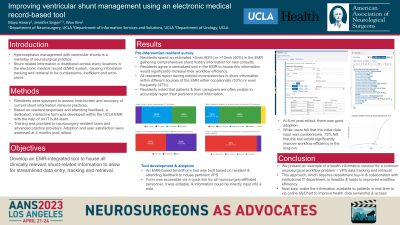Improving ventricular shunt management using an electronic medical record-based tool
Improving Ventricular Shunt Management Using an Electronic Medical Record-based Tool
Friday, April 21, 2023


Maya Harary, MD
Resident
University of California, Los Angeles
Los Angeles, California, United States
ePoster Presenter(s)
Introduction: Hydrocephalus management with ventricular shunts is a mainstay of neurosurgical practice. Shunt related information is distributed across many locations in the electronic medical record (EMR) system, causing information tracking and retrieval to be cumbersome, inefficient and error-prone. We developed a novel tool, built into our institutional EMR system, to house all clinically relevant shunt information to streamline data tracking, retrieval, and accuracy.
Methods: Residents were surveyed to assess time-burden and accuracy of current shunt information retrieval practices. Based on feedback, a dedicated, interactive form was developed within the UCLA EMR (Epic). Training was provided to the neurosurgery team. Adoption and user satisfaction were assessed at 2-months post-rollout.
Results: Residents spend an estimated >5min (93%) or >10min (40%) in the EMR gathering comprehensive shunt history information for new consults. Residents agreed that a centralized EMR tool to house this information would significantly improve workflow. All residents noticed inconsistencies in shunt information within different sources of the EMR, and noted that patients/caregivers are often unable to accurately report pertinent shunt information. An EMR-based tool was built to house ventricular shunt-related information and offer needed functionality to improve workflow. At 2-months post-rollout, there was good adoption of the tool (~20 new patients/month); 35% and 65% were in context of shunt surgery and consults/clinic visits, respectively. While users felt the initial data input was cumbersome, 75% felt that the tool would significantly improve workflow efficiency in the long-run.
Conclusion : We present a health informatics solution for a common neurosurgical workflow problem – tracking pertinent and accurate information for shunted patients. We demonstrate feasibility of this approach, which requires department buy-in and collaboration with institutional IT department, and additionally demonstrate positive potential impact on workflow efficiency. The intended next step is to make the information available in real-time to patients via their eChart to improve health data ownership.
Methods: Residents were surveyed to assess time-burden and accuracy of current shunt information retrieval practices. Based on feedback, a dedicated, interactive form was developed within the UCLA EMR (Epic). Training was provided to the neurosurgery team. Adoption and user satisfaction were assessed at 2-months post-rollout.
Results: Residents spend an estimated >5min (93%) or >10min (40%) in the EMR gathering comprehensive shunt history information for new consults. Residents agreed that a centralized EMR tool to house this information would significantly improve workflow. All residents noticed inconsistencies in shunt information within different sources of the EMR, and noted that patients/caregivers are often unable to accurately report pertinent shunt information. An EMR-based tool was built to house ventricular shunt-related information and offer needed functionality to improve workflow. At 2-months post-rollout, there was good adoption of the tool (~20 new patients/month); 35% and 65% were in context of shunt surgery and consults/clinic visits, respectively. While users felt the initial data input was cumbersome, 75% felt that the tool would significantly improve workflow efficiency in the long-run.
Conclusion : We present a health informatics solution for a common neurosurgical workflow problem – tracking pertinent and accurate information for shunted patients. We demonstrate feasibility of this approach, which requires department buy-in and collaboration with institutional IT department, and additionally demonstrate positive potential impact on workflow efficiency. The intended next step is to make the information available in real-time to patients via their eChart to improve health data ownership.
